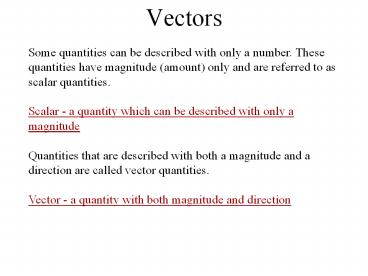Vectors - PowerPoint PPT Presentation
Title:
Vectors
Description:
Title: Vector Laboratory Activity Author: Tom Walsh Last modified by: Thomas Walsh Created Date: 10/7/2001 11:29:34 PM Document presentation format – PowerPoint PPT presentation
Number of Views:81
Avg rating:3.0/5.0
Title: Vectors
1
Vectors
Some quantities can be described with only a
number. These quantities have magnitude (amount)
only and are referred to as scalar quantities.
Scalar - a quantity which can be described with
only a magnitude Quantities that are described
with both a magnitude and a direction are called
vector quantities. Vector - a quantity with
both magnitude and direction
2
Vectors
We can use a graphical method to help us picture
vectors, and to allow us to understand how
vectors are added and subtracted. We will
represent vector quantities with arrows.
The length of the arrow represents its magnitude,
the arrow tip and the direction of the arrow
represent the vector direction.
tip
tail
The point of the arrow is referred to as the
Tip. The non-pointed end is called the Tail
3
Vectors
A vector can be moved (translated) without
changing it. As long as the length and direction
do not change, the vector has not changed.
4
Vectors
A 12 m east
5
Vector Addition
Tip - to - Tail Method of Vector Addition
Steps for adding two vectors using the
tip-to-tail method
1) Draw the first vector (A) to scale, with its
tail at the origin
2) Draw the second vector (B) also to scale, with
its tail at the tip of the first vector
3) The resultant vector runs from the tail end of
the first vector to the tip of the second vector.
6
Vector Addition
Parallelogram Method of Vector Addition
Steps for adding two vectors using the
parallelogram method
1) Draw the first vector (A) to scale, with its
tail at the origin
2) Draw the second vector (B) also to scale, and
also with its tail at the origin.
3) Starting at the tip of one vector, draw a
dotted line parallel to the other vector. Repeat,
starting from the tip of the second vector.
4) The resultant vector runs from the origin to
the intersection of the two dotted lines.
7
Vector Addition
8
Vector Addition
The methods work no matter the direction of the
original vectors.
Tip - to - Tail Method
Parallelogram Method
9
Vector Addition
If you need to add more than two vectors, the
tip-to-tail method is usually easiest.
Note that the order the vectors are added does
not affect the result.
10
Vector Addition
The process of adding two or more vectors is
called Vector Addition. The sum of two or more
vectors is called the resultant vector.
11
Vector Subtraction
For any vector A, the vector -A is simply a
vector equal in magnitude and opposite in
direction to A.
12
Vector Subtraction
13
Vector addition Mathematical Method
To add two perpendicular vectors mathematically,
make a sketch of the two vectors you are adding,
and use either graphical method to sketch their
resultant. To find the magnitude of the
resultant, use the Pythagorean theorem.
To find the direction of the resultant, use an
inverse trig function, for example tan-1
Tan? B/A ? tan-1(B/A)
14
Finding Vector Components Mathematical Method
To break a vector down into perpendicular
components, first make a sketch of the vector.
Sketch dotted lines from the tip of the vector
and parallel to each axis. Draw in the
components, from the origin to the dotted line.
?
To calculate the magnitude of the components, use
the sin and cos functions.
Sin? CN/C
C CE CN
CN C sin?
CE C cos?
Cos? CE/C
15
Finding Vector Components Mathematical Method
16
Finding Vector Components Mathematical Method
17
Finding Vector Components Mathematical Method
18
Finding Vector Components Mathematical Method
(AB)E
19
Finding Vector Components Mathematical Method
(AB)E
20
Finding Vector Components Mathematical Method
(AB)N
(AB)E
21
Finding Vector Components Mathematical Method
AB
(AB)N
(AB)E

